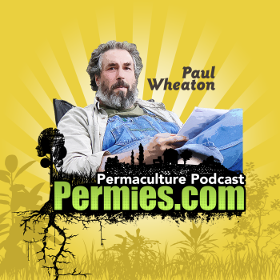 Listen Online
Listen Online  Download
Download  Get all of the podcasts in convenient, giant zip files
Get all of the podcasts in convenient, giant zip files  Subscribe on iTunes
Subscribe on iTunes Summary
Credit:
Summary
Credit: Kevin Murphy
Paul visits with
Helen Atthowe, goddess of the soil. She has a new web site she calls
veganic permaculture.
Paul and Helen talk about how they are going to not talk about pH and conifers. They do talk a bit about
conifer allelopathy and skim over what their current conflicting theories are about how conifers impact
soil pH. Helen explains that adding Pine needles will not lower ph in soil. She also adds how wood bark can help lower ph when she did some studies using containers. Helen goes on to talk about how planting conifers and growing them will lower the ph over 30 to 50 years one unit. Putting needles down for blueberries may not benefit them all that much.
Paul and Helen again say they are not going to talk about
till vs. no-till vs. minimum till.
Paul and Helen talk about about how Helen was not so keen on the word “permaculture” in the past, but is now into
permaculture whole hog. Helen discusses her annual crop and perennial crops. Helen reviews the ecological approach to Forest Gardening and Agro Forestry. She studied under Wes Jackson but also was trained formally in conventional agriculture.
Helen reviews her first hand experience with
Masanobu Fukuoka. She spends some time on Fukuoka’s
soil building techniques on his
rice and barley fields. Helen explains how farming from Fukuoka s perspective is about observing and learning from more of a spiritual sense. As a teacher Fukuoka's approach is not about technique as much as it is about observing nature. Pay attention to the natural world. It is not an easy skill but you must open your eyes and ears to observe nature.
Paul and Helen review how mono cultures are not as productive as poly cultures. Fukuoka's techniques use succession planting. A legume cover crop followed by a straw crop which created a balance of nitrogen and carbon. They also talk about how much
nitrogen a legume exudes while it is alive, how much when it dies and how much it loses to denitrification when left on the surface.
In Georgia, Helen made clay balls with corn. She explains how she carved a small trench and placed the clay ball in place. She used rye as a straw mulch with legumes in between. Succession of these phases is explained and mimics what happens in a grassland system.
Paul discusses if tilling in a legume is necessary. If you have an annual legume Paul gives his ideas on how a legume would break down and how Fukuoka never tilled. Helen explains how she thinks Fukuoka's system worked. Helen feels that by building the soil constantly Fukuoka's soil was producing consistent yields. By putting nitrogen in the bank it could be utilized in the future. Paul reviews the production rates on Fukuoka's farm and how perennial clover helped build his soil.
Paul and Helen then review how much damage tilling does to our soil. Fukuoka's system is very elegant using no till. There is some research being down to look at no till options. Helen discusses her website and where to find her work. Helens website is called
veganic permaculture.
Resources
The One-Straw Revolution
Amazon.com
Amazon.ca
Amazon.co.uk
Sowing Seeds in the Desert
Amazon.com
Amazon.ca
Amazon.co.uk
Relevant Links
Helen Atthowe: goddess of the soil
Soil Forum
How does subsoil tillage build soil?
Support the Empire
Help support the empire and get all of the podcasts in bundles
here
To support production of these podcasts, make a donation
here at Paul's Patreon page.












